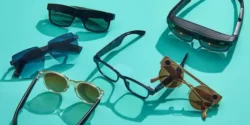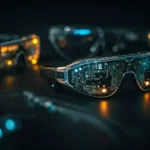What Do Smart Glasses Do? Enhancing Your World, Hands-Free
Smart glasses, wearable technology that overlays digital information onto the real world, are rapidly evolving. For individuals with EAAT (Electronic Assistive Technology) needs and the general public alike, these devices offer a range of compelling benefits and advantages. Whether you’re an iPhone or Android user, understanding the potential of smart glasses can open up new possibilities for independence, communication, and productivity. Read on to learn more about the smart glasses benefits and advantages of wearing smart glasses.
Smart Glasses Benefits and Advantages
Smart glasses provide several key advantages:
- Hands-free Access: This is a significant benefit for individuals with motor impairments, allowing them to access information, communication tools, and even control other devices without using their hands.
- Real-time Information: Imagine having directions, translations, or important notifications appear directly in your line of sight. This can enhance navigation, communication, and situational awareness.
- Enhanced Communication: Some smart glasses offer features like captioning for conversations, which can be invaluable for individuals with hearing impairments. They can also facilitate remote communication through video calls.
- Improved Independence: For people with disabilities, smart glasses can provide greater autonomy in daily tasks, from reading menus to controlling smart home devices.
- Augmented Reality (AR) Experiences: AR overlays digital content onto the real world, offering potential applications in education, training, entertainment, and assistance with tasks like repairs or assembly.
- Discreet Assistance: Compared to other assistive technologies, smart glasses can be more subtle and integrated into daily life, reducing stigma.
Best Use Cases – Smart Glasses Benefits and Advantages
The applications of smart glasses are diverse and continue to grow. Here are some key use cases:
Smart Glasses Benefits For EAAT Users:
- Communication: Real-time captioning of conversations (Link to National Association of the Deaf on Captioning), alternative communication methods through eye-tracking or voice commands.
- Environmental Control: Hands-free control of smart home devices (lights, thermostats, etc.) (Link to AbilityNet on Smart Home Technology).
- Navigation: Discreet turn-by-turn directions for visually impaired individuals or those with mobility challenges.
- Reading Assistance: Optical Character Recognition (OCR) to read printed text aloud.
- Remote Assistance: Connecting with caregivers or support personnel via video call for real-time help.
Smart Glasses Benefits For iPhone and Android Users (General Public):
- Navigation: Hands-free directions for driving, cycling, or walking.
- Information Access: Quick access to weather updates, notifications, and calendar events.
- Photography and Videography: Capturing first-person perspectives without needing to hold a phone.
- Entertainment: Immersive AR gaming and media experiences.
- Productivity: Accessing task lists, notes, and communication tools on the go.
- Translation: Real-time language translation during conversations.
Compatibility with iPhone and Android
Most smart glasses are designed to be compatible with both iOS (iPhone) and Android smartphones via Bluetooth or Wi-Fi. Typically, a companion app on your phone manages the connection, settings, and data transfer with the smart glasses. Always check the manufacturer’s specifications to ensure compatibility with your specific phone model and operating system version.
Troubleshooting Common Problems
While smart glasses benefits are numerous, users may encounter some common issues:
- Connectivity Problems: Ensure Bluetooth is enabled on both your phone and the glasses. Try unpairing and re-pairing the devices. Check for software updates for both the glasses and the companion app.
- Battery Life: Smart glasses, especially those with advanced features, may have limited battery life. Optimize usage by turning off unnecessary features and carrying a portable charger.
- Display Issues: Ensure the display is properly calibrated and the brightness is adjusted. Clean the lenses with a microfiber cloth.
- App Compatibility: Not all smartphone apps are optimized for smart glasses. Check the companion app for a list of supported applications.
- Comfort and Fit: Proper fit is crucial for comfort. Adjust the nose bridge and temple arms according to the manufacturer’s instructions.
- Software Glitches: Restarting the smart glasses or the companion app can often resolve minor software issues. Check for and install any available software updates.
Frequently Asked Questions (FAQ)
Q: Are smart glasses expensive? A: The price of smart glasses can vary widely depending on the features and brand. Some basic models are relatively affordable, while more advanced AR-enabled glasses can be quite costly.
Q: Are smart glasses easy to use? A: The ease of use can vary between models. Many smart glasses are designed with intuitive interfaces and voice control. However, there may be a learning curve associated with some features and navigation methods.
Q: What are the privacy implications of using smart glasses with cameras? A: Privacy is a valid concern. Users should be mindful of when and where they are recording. Most devices have indicators to show when the camera is in use. It’s essential to understand and respect local privacy laws and the privacy of others.
Q: Can I wear smart glasses with my regular eyeglasses? A: Some smart glasses are designed to be worn over prescription glasses, while others offer prescription lens inserts. Check the manufacturer’s specifications for compatibility.
Q: What is the future of smart glasses? A: The field of smart glasses is rapidly evolving. Future developments are likely to include more advanced AR capabilities, improved battery life, sleeker designs, and wider adoption across various industries and for personal use. (Link to IEEE Spectrum on Wearable Technology)
Smart glasses benefits hold immense potential to enhance accessibility for individuals with EAAT needs and offer valuable benefits for all smartphone users. As the technology continues to advance and become more integrated into our lives, understanding its capabilities and addressing potential challenges will be key to unlocking its full potential.
Popular Smart Glasses Brands
Here are some of the most popular brands of smart glasses and a comparison chart of their features. It’s important to note that the smart glasses market is rapidly evolving, with new models and technologies being released frequently. The following is a snapshot of some of the leading brands and their key offerings.
- Meta: In partnership with Ray-Ban and Oakley, Meta produces stylish smart glasses that focus on hands-free photography, video recording, audio, and access to their Meta AI assistant. They are a popular choice for their fashionable design and seamless integration with social media platforms.
- XREAL (formerly Nreal): Known for its focus on augmented reality (AR) and virtual screens. XREAL glasses are designed to function as a portable, large display for your phone, laptop, or gaming console, making them popular with gamers, developers, and digital nomads.
- Viture: A brand that specializes in high-quality AR glasses, often with a focus on gaming and multimedia. Viture’s products are known for their high-resolution displays and a strong ecosystem of compatible accessories.
- Rokid: Rokid offers a range of AR glasses with a particular emphasis on a wide field of view and features that are useful for both consumers and enterprise applications. Some models include built-in focus adjustment dials for users with myopia.
- Amazon: With their Echo Frames, Amazon focuses on providing a hands-free, audio-centric experience. These glasses integrate with the Alexa voice assistant, allowing users to make calls, listen to music, and control smart home devices without pulling out their phone.
- TCL RayNeo: A brand from a major display technology company, TCL, RayNeo offers smart glasses with strong display quality and a focus on immersive entertainment and productivity.
- Lucyd: Lucyd specializes in audio-focused smart eyewear, often integrating with AI assistants like ChatGPT. Their glasses are a good option for those who want hands-free audio and AI access without a visual display.
Smart Glasses Feature Comparison Chart
This chart provides a high-level comparison of features across various popular smart glasses models. Keep in mind that specific features can vary between different models within a single brand.
| Feature | Ray-Ban Meta Smart Glasses | XREAL Air 2 Ultra | Viture Pro XR | Rokid Max 2 | Amazon Echo Frames (3rd Gen) |
| Primary Use Case | Hands-free content capture, AI | AR, virtual screen, gaming | AR, mixed reality, gaming | AR, entertainment, productivity | Hands-free audio, Alexa |
| Display Type | No visual display (camera/audio) | Micro-OLED | Micro-OLED | Micro-OLED | No visual display (audio) |
| Resolution | N/A | 1920×1080 per eye | 1920×1080 per eye | 1920×1080 per eye | N/A |
| Field of View (FoV) | N/A | 52° diagonal | 46° diagonal | 50° diagonal | N/A |
| Camera | Yes (12MP) | Yes (with sensors) | No | No | No |
| Microphone & Speakers | Yes (open-ear audio) | Yes (open-ear audio) | Yes (Harman Audio) | Yes | Yes (open-ear audio) |
| AI Assistant | Meta AI | None (connects to phone) | None (connects to phone) | None (connects to phone) | Alexa |
| Connection | Wireless (Bluetooth/Wi-Fi) | Wired (USB-C) | Wired (USB-C) | Wired (USB-C) | Wireless (Bluetooth) |
| Stand-alone Operation | Yes (for basic functions) | No | No | No | Yes (for basic functions) |
| Myopia Adjustment | Yes (prescription lenses) | Yes (prescription inserts) | Yes (diopter adjustment) | Yes (diopter adjustment) | Yes (prescription lenses) |
| Weight | ~49g | ~87g | ~77g | ~79g | ~37-46g |
| Price Range | Mid-to-high | High | High | Mid-to-high | Mid-range |
Additional helpful information:
- What about the future of smart glasses? – The Future of Smart Glasses – What is coming?
- Details about the different technologies used for smart glasses — Smart Glasses Technology




